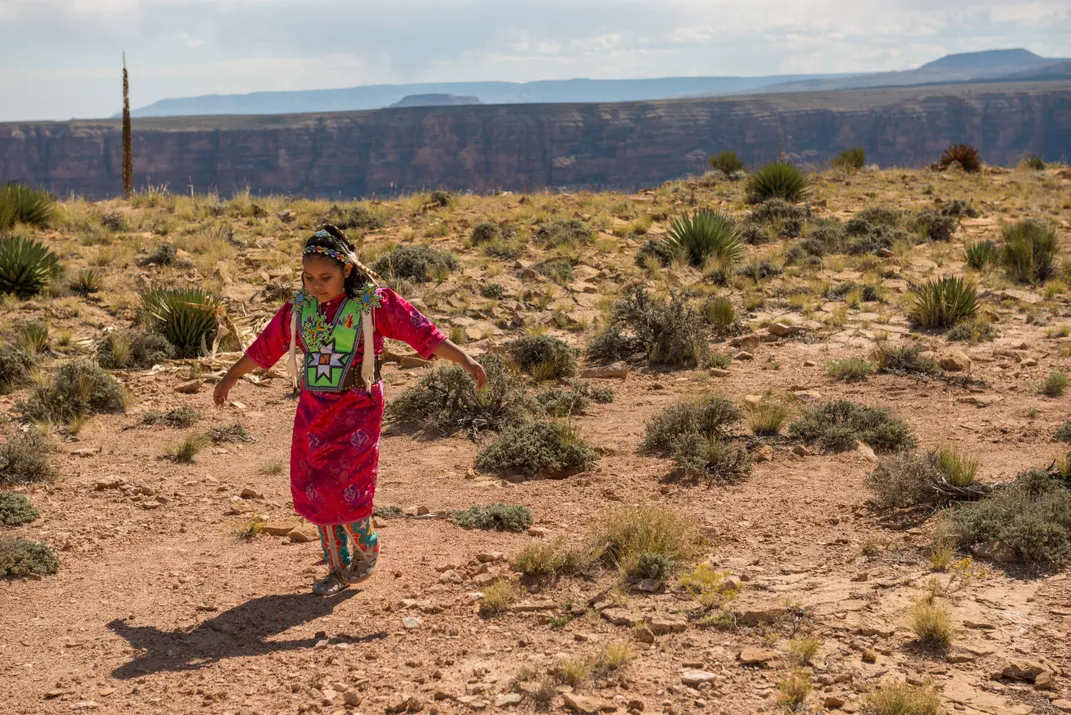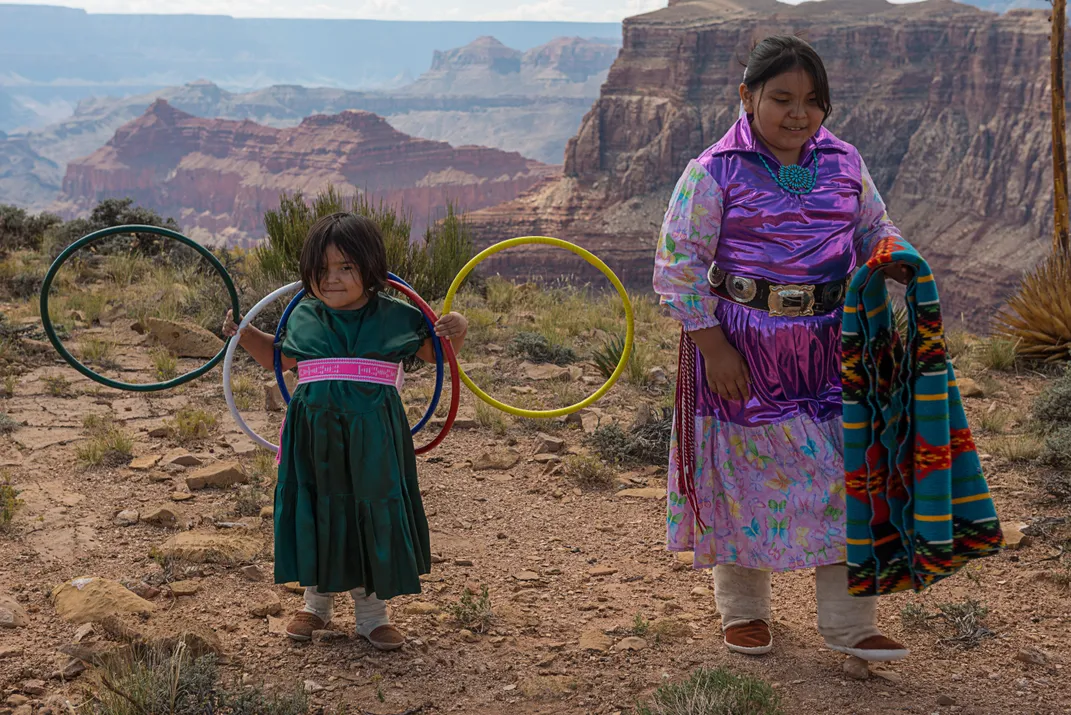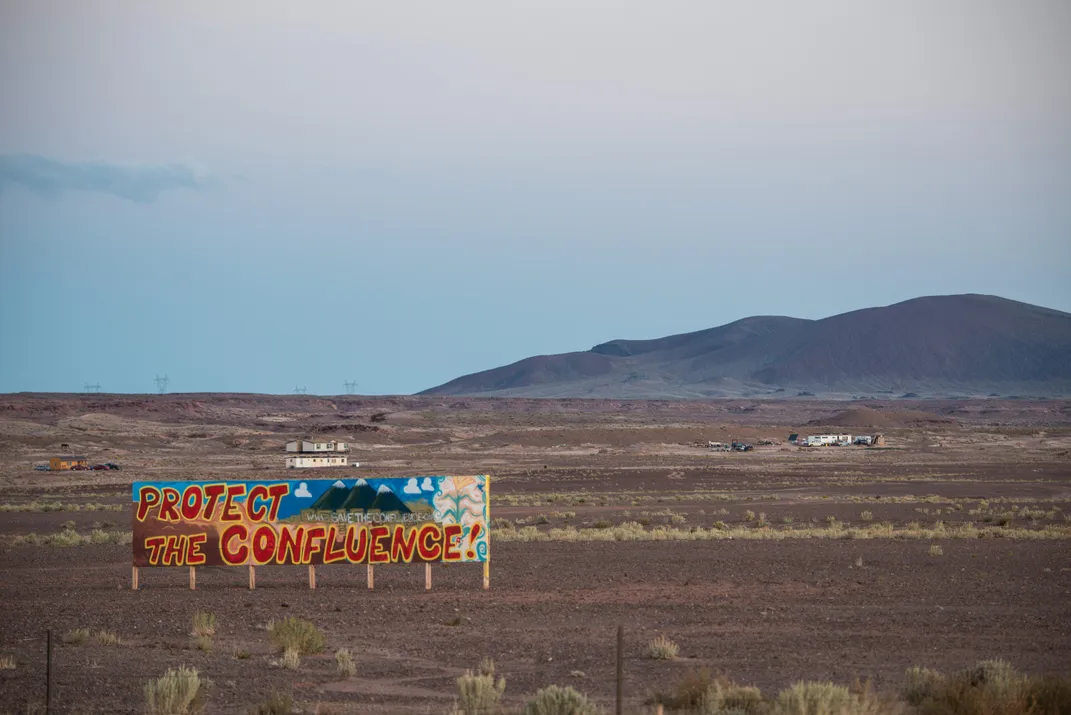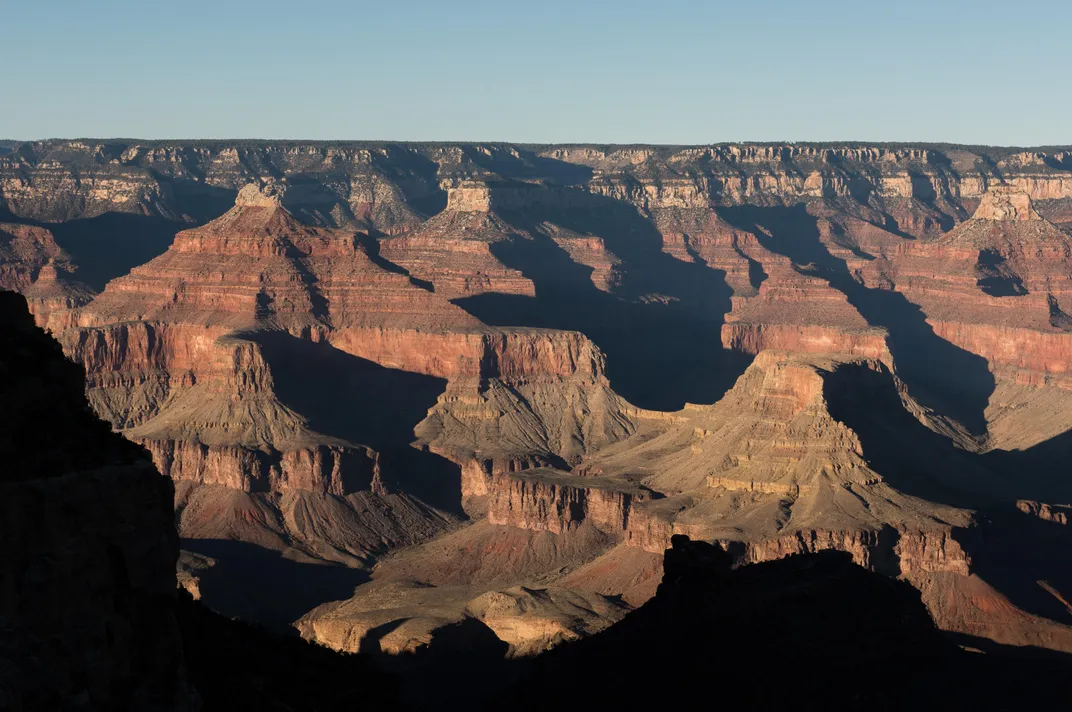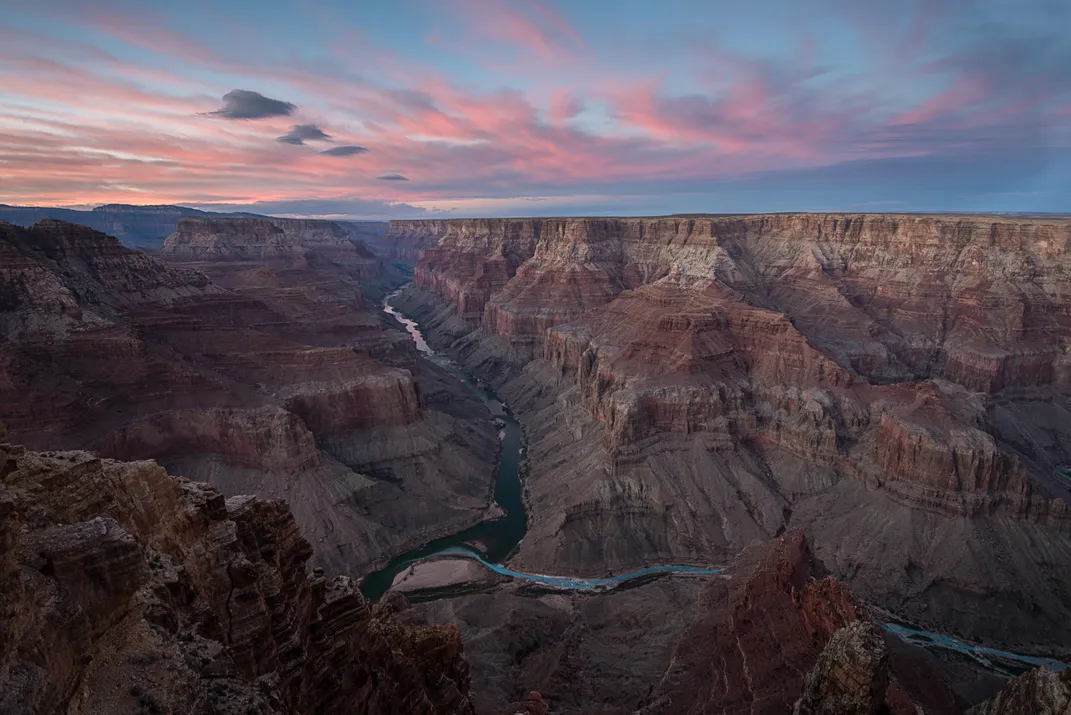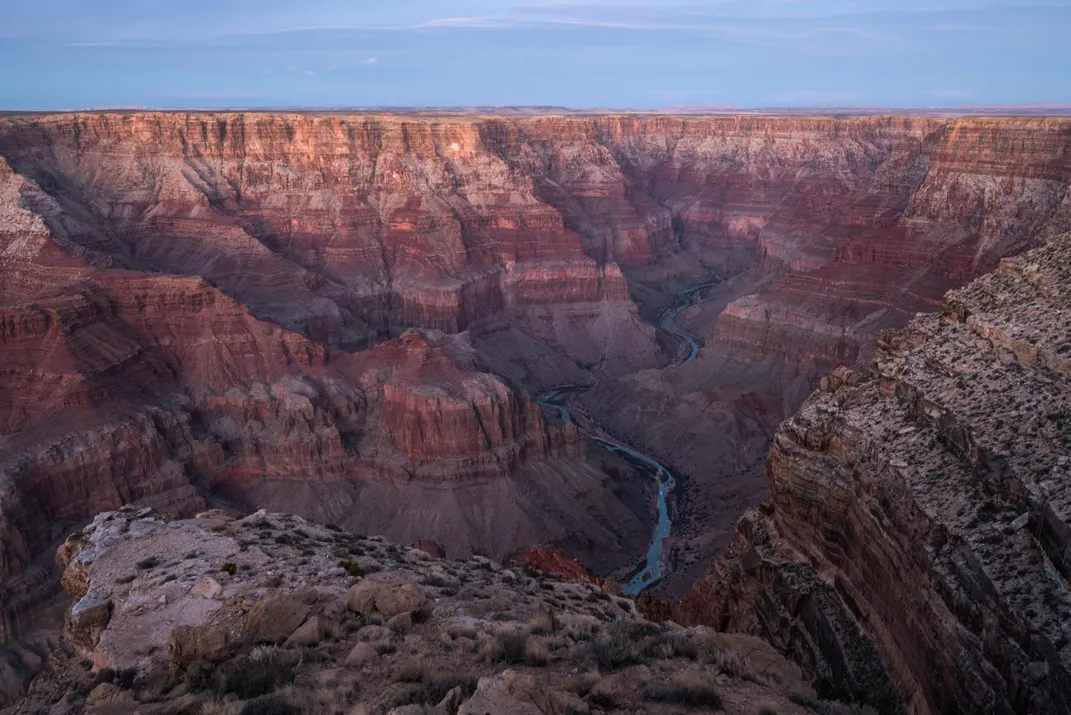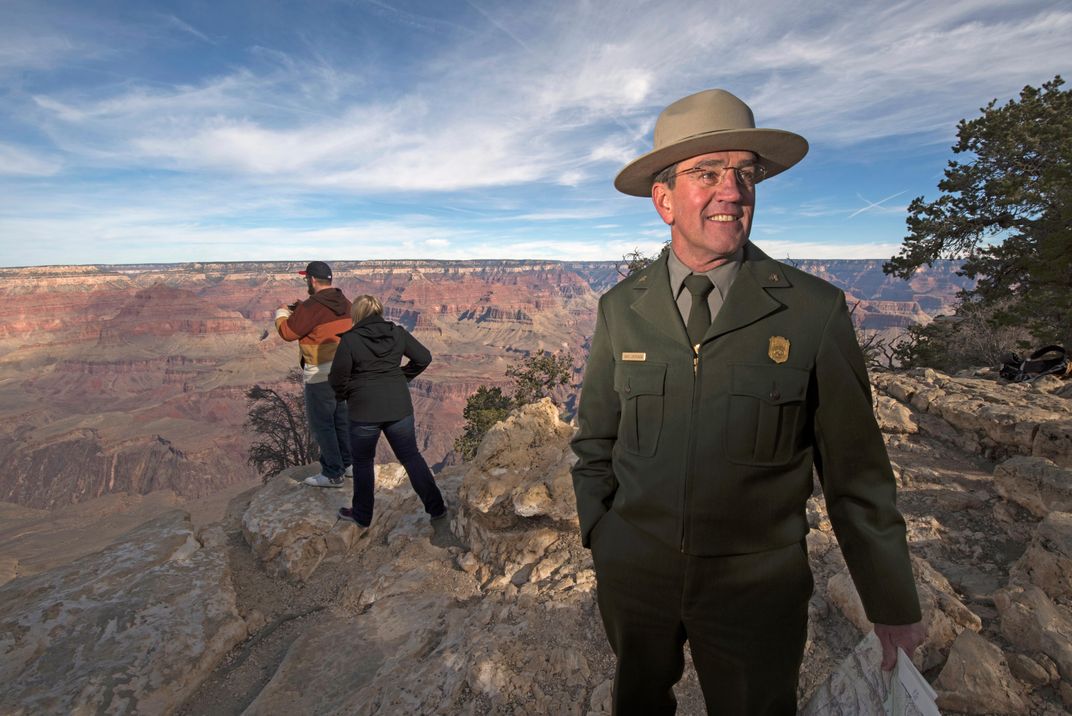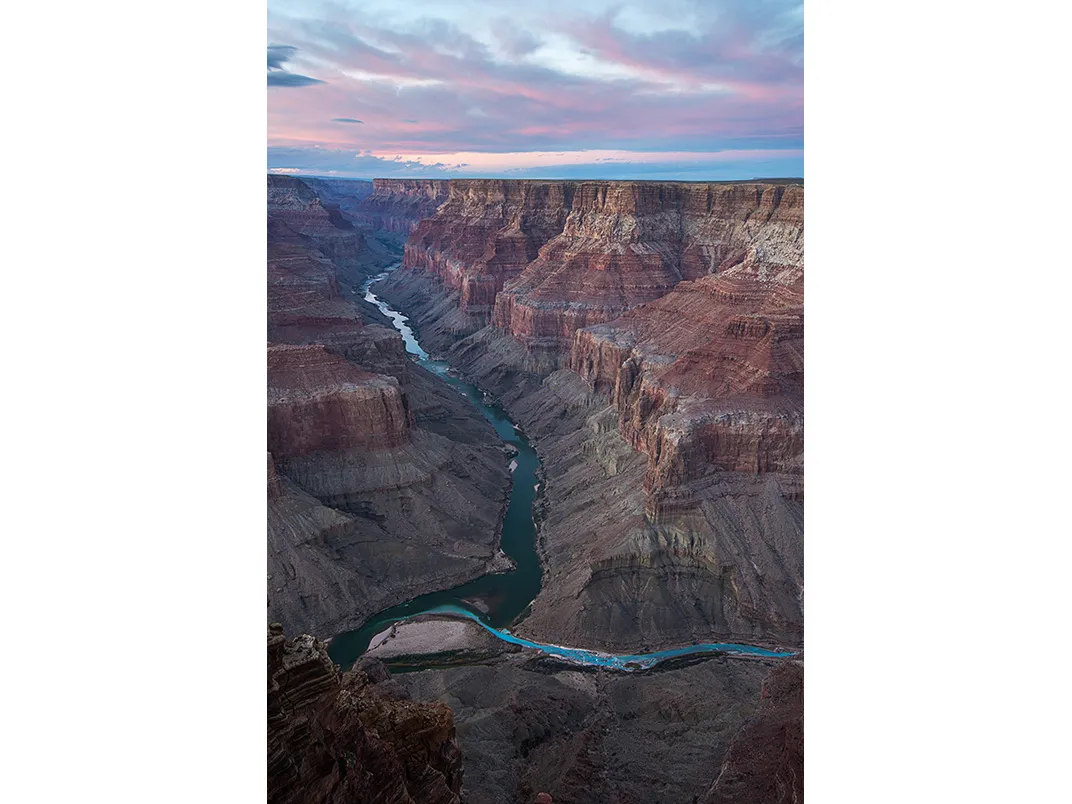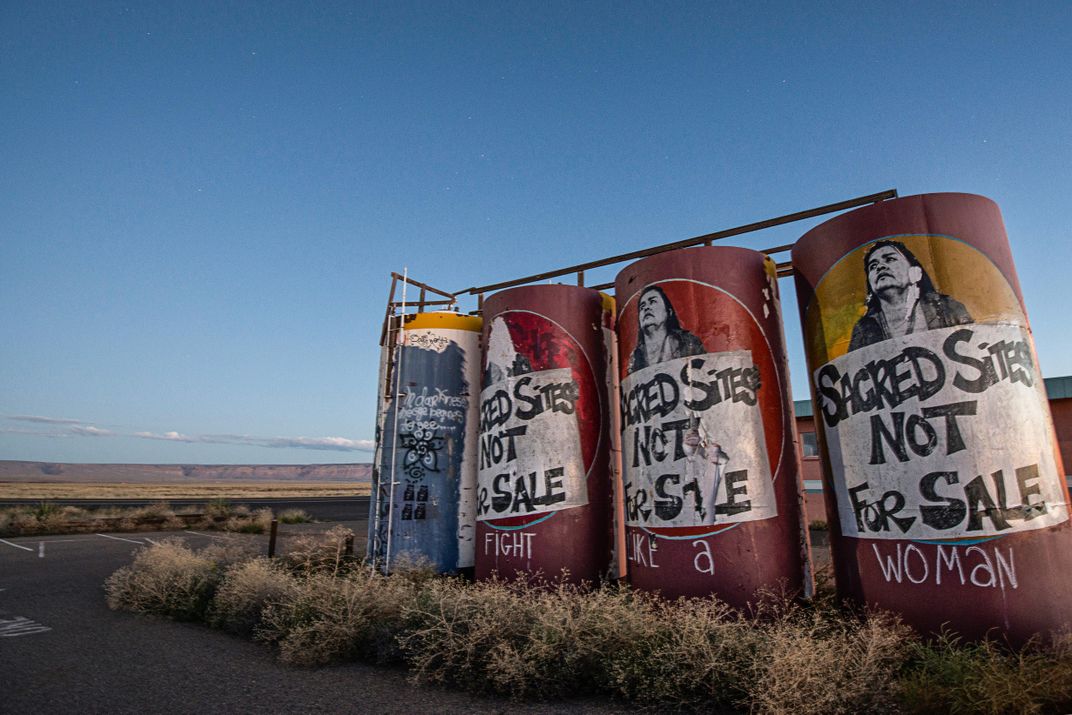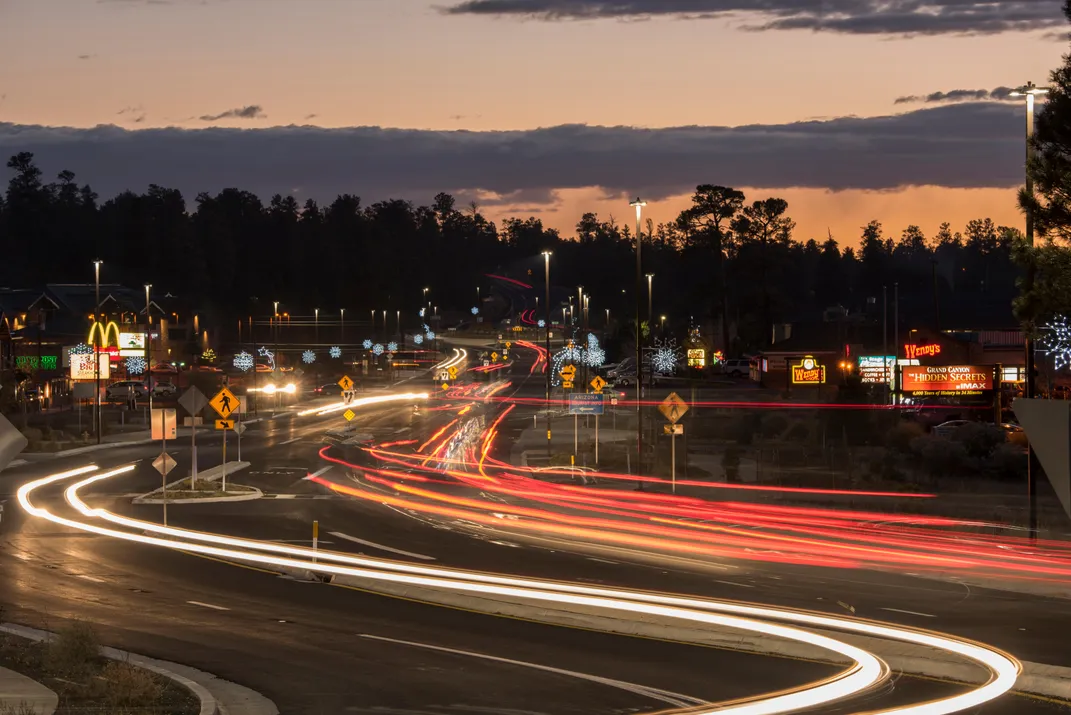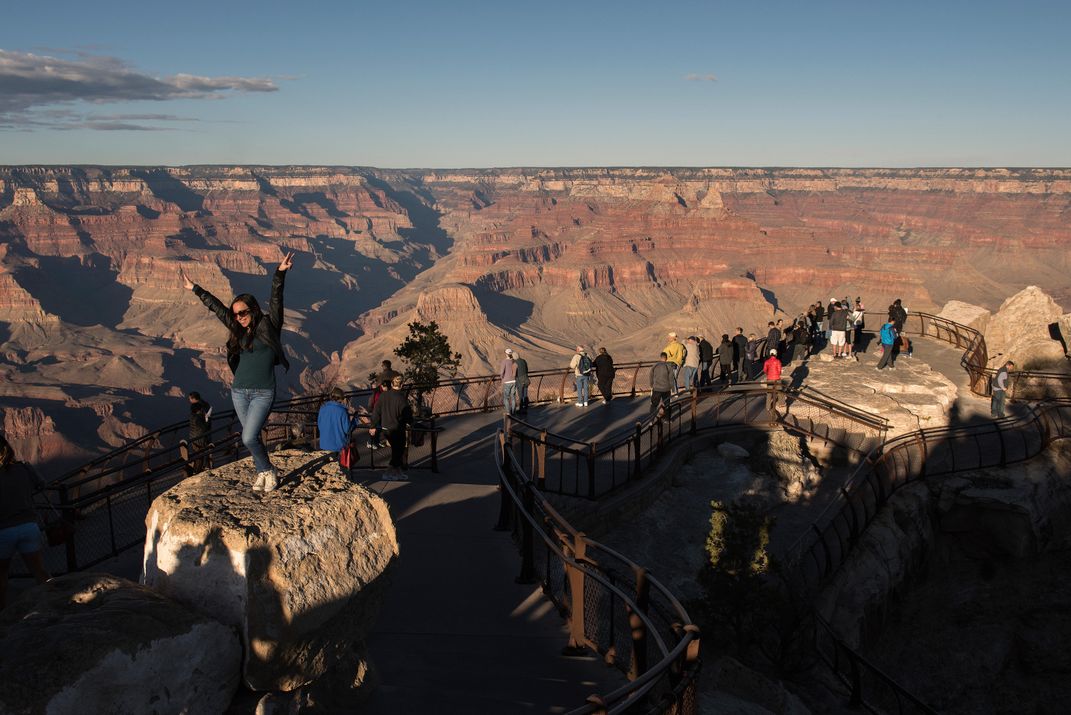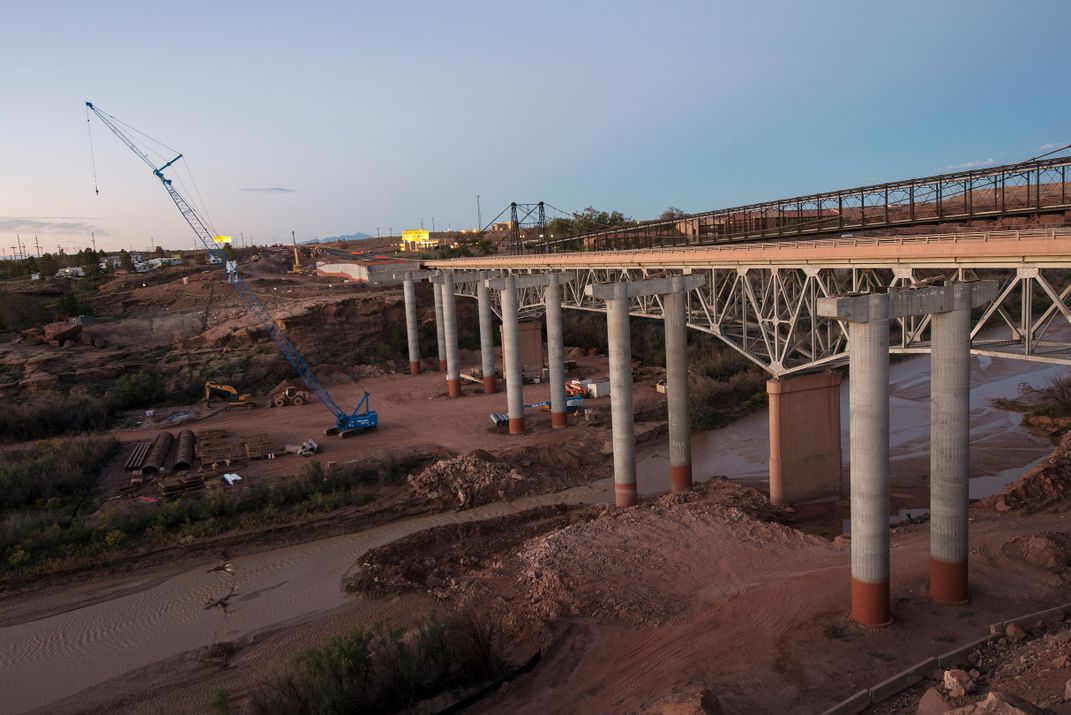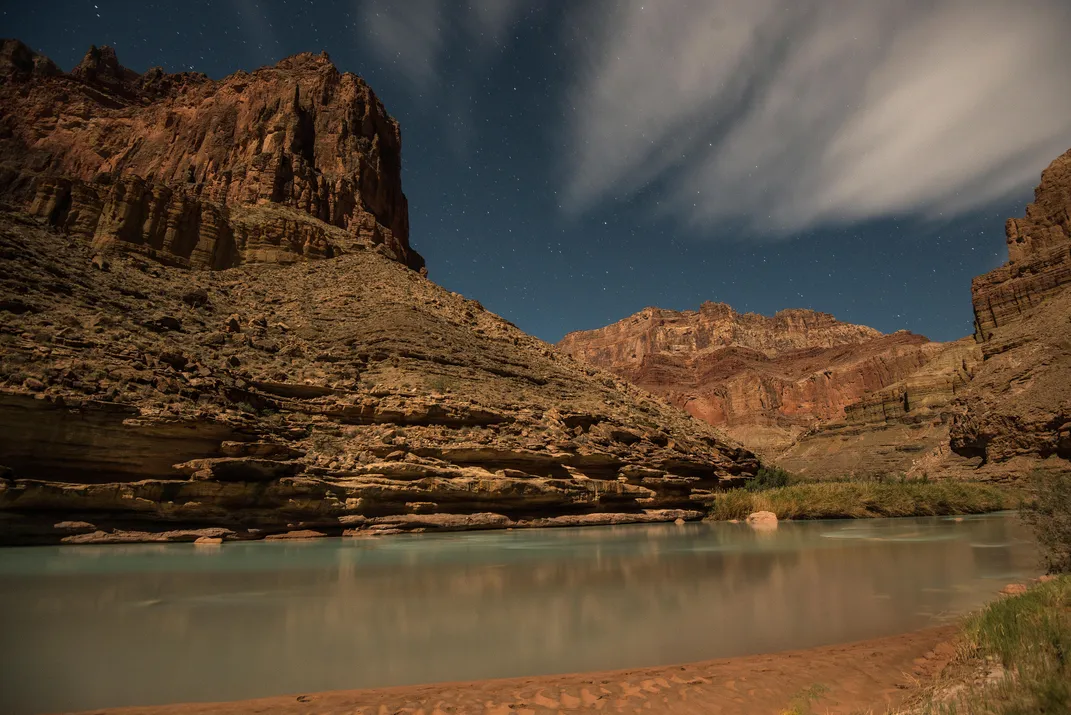Who Can Save the Grand Canyon?
A holy war is being fought over a proposal to build a $500 million commercial development, on the rim of America’s natural treasure
/https://tf-cmsv2-smithsonianmag-media.s3.amazonaws.com/filer/b8/05/b805ffe1-a2d3-4284-b53b-c27f380e8c1e/mar2015_f05_grancanyon.jpg)
Twelve miles in on the rutted dirt road we pull over in a dry wash and get out of our vehicles. We are on the western edge of the Navajo Reservation in Arizona, not far from the sandstone rim where the Grand Canyon plunges 3,000 feet to the confluence of the Colorado and Little Colorado rivers. The bare plateau across which we are driving is treeless, almost desolate. The region, nearly uninhabited today, was for centuries home to some of the most traditional of the Diné, as Navajos call the People.
Our guide to this outback, Delores Wilson, grew up on the plateau and knows every wrinkle of its landscape. “In summer, when we herded the sheep on our way home,” Wilson says, “we used to stop here and cool off in the shade. I had two sisters, six brothers and countless cousins. We all herded sheep when we were kids.”
Four miles farther in, we stop by the half-collapsed ruins of a small building. “This was my grandmother’s hogan,” says Wilson. “Until I was 7 or 8, we all slept in there, all 10 or 15 of my family, because we didn’t have a home of our own. Packed together like sardines, to stay warm in winter. I can still hear the sheep wailing for the lambs to come home in the evening.”
Our next stop is another six miles west, beside a nondescript bedrock shelf. “This is where I had my puberty ceremony,” says Wilson. “I had to run in all four directions. The other kids ran after me. If they passed me, they’d get old before I did.
“This takes me back,” she says wistfully. “So much history, so many ceremonies.”
After nearly three hours, we approach the rim above the confluence. Wilson grows somber—as does her close friend Renae Yellowhorse, whose Aunt Nelly, in her 80s, still lives out here without running water or elec-
tricity, still herding sheep. Staring south, Wilson says, “Grandma told us to stay away from the canyon. You don’t throw rocks in there. That’s where the Holy Beings are.”
Renae Yellowhorse adds, “My mother was told by my great-grandmother, ‘You don’t go to the rim without a serious reason. You don’t go there just to look. You go there with your corn pollen to pray to the Holy Beings.’”
“We never used to talk about this place,” Wilson offers. “Now we have to, because of the Escalade.”
When Teddy Roosevelt declared the Grand Canyon a national monument, in 1908, he famously said: “Leave it as it is. You cannot improve on it. The ages have been at work on it, and man can only mar it.” In that sense, the Escalade is a thumb in TR’s eye. Covering hundreds of acres on Navajo Reservation land, it is arguably the most intrusive development ever proposed for the Grand Canyon—a $500 million to $1.1 billion recreation and transport facility featuring a 1.4-mile tramway equipped with eight-passenger gondolas that would carry as many as 10,000 people a day down to the river confluence, with new roads, hotels, gift shops, restaurants and other attractions. The developer—Confluence Partners LLC, a Scottsdale, Arizona-based investment group whose members’ ventures include real estate, resorts and theme parks—says construction of the Escalade could begin as early as this year.
Little known to the public at large, this massive commercial undertaking has become so controversial that the debate about building the Escalade is itself a confluence, a turbulent coming-together of powerful forces that promise to shape America’s most iconic natural wonder for generations. On one side are investors, local business people and some Native Americans, who are interested in the profits and jobs from building the facilities and running them, and then there is a handful of what might be called libertarian-minded supporters, who like the idea of enabling a large number of people to enjoy the great canyon’s very heart, a stunningly beautiful and remote site long inaccessible to the masses. On the other side are national park officials, environmental advocates, park visitors and Native Americans, who would prefer that the site remain as is. That the Escalade’s legality is still in doubt—most likely a matter for the courts—only adds to the turmoil.The project has divided the Navajo Nation, and also ignited opposition from members of other tribes. Wilson and Yellowhorse are principals in a grass-roots movement called Save the Confluence, but they are keenly aware that other Navajos are all in favor of the proposed development. For their part, Confluence Partners says it has “uncovered no evidence of any sacred sites within the project boundaries or that would be negatively impacted by the project.”
And the confluence, it turns out, is not the only point of contention. Twenty-five air miles to the southwest, another group of entrepreneurs is planning a mammoth expansion of the tiny gateway community of Tusayan, just outside the limits of Grand Canyon National Park. The Phoenix-based Stilo Development Group USA—a branch of an Italian investment company that has bought up thousands of acres in the area—proposes building 2,200 new homes (including affordable housing), as well as hotels, restaurants, a shopping center, an “entertainment pavilion” based on Native American themes, a spa, a water slide and a dude ranch. Construction could begin within two to three years, says Tusayan mayor Greg Bryan, depending on when access might be granted by the U.S. Forest Service.
Environmentalists, including the Sierra Club and the Grand Canyon Trust, oppose the Tusayan project, in the works for more than two decades. “Conservation groups deplore the ‘Disneyfication’ of the Grand Canyon,” says David Nimkin, Southwest regional director of the National Parks Conservation Association. The greatest threat the Tusayan development poses to the vast wilderness of the Grand Canyon, some critics say, could be the diminishing of the South Rim aquifer, which would cause springs and oases far below the rim to dry up significantly.
The plan to expand Tusayan, though contested in its own right, has not inflamed emotions as much as the Escalade proposal, partly because the Tusayan project has long been in the works and partly because it would only enlarge the infrastructure of an existing tourist complex that dates back to the early 20th century, when the first hotels, shops and a railroad were built.
By contrast, the Escalade, which has reached a state of white-hot urgency in only a few months, is an entirely new development. The gondola complex would tear a mechanized gash through the canyon from rim to river. In a place that has forever been a paradise of silence and pristine nature, the tramway could generate almost constant noise and light pollution, the chatter of tourists giddy with the ultimate Coney Island ride and the clutter that hotels and gift shops and hot dog stands inevitably produce.
Taken together, the proposed Tusayan and Escalade developments are unprecedented, says Dave Uberuaga, superintendent of Grand Canyon National Park: “These two projects constitute the greatest threat to the Grand Canyon in the 96-year history of the park.”
In the awesome beauty of the Grand Canyon’s 277 miles of river passage, of the national park’s 1,902 square miles of cliff and ledge and rim and pinnacle (a tract the size of Delaware), the true heart of the Grand Canyon has always been the confluence.
The first non-natives to reach the junction were the team under Maj. John Wesley Powell, who made the first descent of the Colorado River in 1869. By August 10, two and a half months into their voyage, the men had already lost one of their four wooden dories, along with vital food, and had suffered several capsizes. The mood in camp during a several-day stay at the confluence veered between optimism and foreboding.
Having barely begun their journey through the Grand Canyon, the men also thrilled to the challenge of pathbreaking adventure. As Powell wrote on August 13: “We are now ready to start on our way down the Great Unknown....What falls there are, we know not; what rocks beset the channel, we know not; what walls rise over the river, we know not.”
Soon, Powell was reporting, “The cañon is narrower than we have ever before seen it; the water is swifter; there are but few broken rocks in the channel; but the walls are set, on either side, with pinnacles and crags; and sharp, angular buttresses, bristling with wind and wave polished spires, extend far out into the river.”
Long before Powell, however, Native Americans held the confluence as sacred. For the Hopi, as well as for other tribes, it is central to their origin story. The sipapu—a travertine bulge of mineral deposits with a hole in the center, which lies on the banks of the Little Colorado River a short distance upstream from the confluence—is the place through which all human beings migrated from the subterranean Third World to today’s Fourth World.
Today, hikers traipse across the limestone mound, treating it as if it were a stop on a sightseeing tour, though they are not the first to be oblivious to the spot’s significance. Around 1912, a young Hopi man on his first pilgrimage to the confluence was deeply shocked by what he found there. “Some ignorant, foolhardy Whites had plunged two poles into the sacred sipapu, and left them standing against the west wall,” he later recalled to an ethnographer. “Those profane fellows had desecrated the sacred spot where our ancestors—and theirs—emerged from the underworld. It was a great disgrace.”
For centuries, the Hopi made extremely rugged treks (160 miles round-trip) from their mesas in northeastern Arizona to a sacred source of salt at the bottom of the Grand Canyon, a few miles up the Colorado River from the confluence. To reach the canyon base, they traversed a hazardous 3,000-foot descent on the Salt Trail, via a side canyon off the Little Colorado. Obtaining salt—a precious commodity in the Hopi diet—was essential, but the journey was also a ritual designed to ensure fertility and rain.
The most vivid published account of the pilgrimage is found in Sun Chief, the autobiography of Don Talayesva, who as a young man participated in one of the last of these quests. With his father and the tribe’s war chief, he camped overnight at the confluence. It was for the Hopi both a miraculous and a ghostly place, the haunt of Masau’u, god of fire and death. As Talayesva recalled decades later, “I kept looking around. The War Chief said, ‘If you look around too much you may see an evil spirit.’” The Hopi knew that if they failed to perform the rituals correctly, they might come home to find a loved one dead, or to face weeks without rain.
After 1912, thanks to the availability of salt from Anglo traders’ stores, the pilgrimages ended. But the Hopi still believe that the base of the Grand Canyon, near the confluence, is where their spirits reside after death. As Leigh Kuwanwisiwma, Hopi cultural preservation officer, says, “My mother died in her 90s in 2012. A year later, I stood on the rim of the canyon [near the confluence overlook] and thought about my mom, my dad, my grandparents as I looked into the canyon. I thought, ‘Can’t we give our people solitude? The spirits need to be left alone.’”
For the Zuni, living today in western New Mexico and eastern Arizona, the confluence also has deep cultural significance. “Our place of emergence is also within the Grand Canyon,” says Jim Enote, director of the A:shiwi A:wan Museum and Heritage Center in Zuni, New Mexico. “It’s at Ribbon Falls. Our people lived a very long time in the canyon. Then we journeyed out and explored the tributaries throughout the Colorado Plateau, until we settled where we live now. We still make pilgrimages every year into the canyon, to collect plants and minerals and leave offerings. We have shrines there that have never been abandoned. The confluence is a very important place. We also put offerings into the Zuni River, and if you follow the Zuni downstream, it flows into the Little Colorado; the Little Colorado flows into the Colorado. So our offerings flow to the confluence, which connects us to our place of emergence.”
The scale of the Grand Canyon is too colossal to apprehend on first encounter. Gazing into its immensity from a vehicle pull-out on the South Rim can be a static exercise—viewing mere scenery, rather than encountering sublimity.
In my experience, the best way to grasp the Grand Canyon is to hike, and to get below the rim—and not on one of the most traveled routes, such as the Bright Angel Trail. On his monumental solo traverse of the canyon in 1963, Colin Fletcher reveled in the trance-like experience of discovery and solitude. “Now I could look far out across flat red rock,” he wrote in a typically lyrical passage in The Man Who Walked Through Time, “and watch the long, swift flight of a cloud shadow. And I found that it was a joy and a release to watch one of these shadows dissolve for a moment as it crossed a side canyon, then reappear and race onward, diminishing, until it accelerated up a distant talus slope, vaulted a cliff face, and vanished over the Canyon’s rim, five or eight or even ten miles away.”
In 2006, a few miles south of the confluence, I followed the faintest of prehistoric trails down a remote ravine. Just as I thought the passage had ended in a sheer cliff, I discovered ancient hand- and footholds pounded into the stone, serving as a vertiginous ladder leading to the depths below. I was stunned by this unexpected link to vanished Native Americans for whom, centuries or even millennia before me, the Grand Canyon was not a recreational park, but home.
Because the land on which Confluence Partners hopes to build the Escalade lies on the Navajo Reservation, the entrepreneurs consulted Navajos. This infuriated people from Hopi, Zuni and other pueblos, as well as the Hualapai and Havasupai, who live in the Grand Canyon far to the west of the confluence. As Leigh Kuwanwisiwma says, “Confluence Partners asked the Navajos in Window Rock about our sacred sites! It’s all about money.”
In recent months, Confluence Partners has accelerated its campaign for the Escalade, taking out full-page ads in the Navajo Times and the Navajo-Hopi Observer that imply the Scottsdale developers and the Navajo people speak in a unified voice. “For a very long time,” reads the text of one ad, “people outside the Navajo Nation have suggested or told us what they think we should do. We are hearing those voices again today. This is our land, our decision and our future.”
Uberuaga, the park superintendent, says “Confluence Partners is telling the tribe, ‘Take this land back from the white man.’”
With promises of jobs and economic uplift, Confluence Partners has divided the Navajo Nation against itself. Outgoing president Ben Shelly, whose term officially ended in January, supports the Escalade. But as this article went to press, procedural delays continued to stall election of his successor; candidates are keeping their views of the Escalade close to the vest.
One Navajo supporter of the project is Brian Kensley, manager for the Bodaway-Gap chapter, a tribal unit whose land covers the site of the proposed development. For various reasons, Bodaway-Gap has been for decades one of the poorest chapters on the reservation. “The Escalade just fell into our laps,” Kensley says. “This is what the people want. They want jobs.
“I think this project will make the land out there more sacred. The Native American visitor center at the overlook will give a real interpretation of the Navajo, the Hopi, the Zuni, not some anthropologist’s view. What’s so sacred about a place that leaves people in poverty?”
The Escalade developers promote their plan as a way of democratizing the visitor experience. “Why should we restrict the [bottom of] the canyon?” asks R. Lamar Whitmer, Confluence’s managing partner, “to the hikers and rafters who can afford a $5,000 river trip?” A posting on the company’s website asks, “More on Sacred Sites—Where Do 24,567 Rafters Go to Party?”
It’s true that a favorite stop of the commercial companies and private outfits rafting the Colorado is the confluence, where folks hike up the Little Colorado to wade in the shallow blue-green water of the travertine pools. A party atmosphere—or at least a picnic vibe—usually obtains. On my own trip on the Colorado about 20 years ago, we clients, led by our guides, did just that.
A new approach, however, may soon supersede such thoughtless antics. Robert Jenkins is the only licensed Hopi rafting guide in the Grand Canyon. He says, “Playing in the riffles of the Little Colorado still happens. It’s hard to stop other companies from doing it. But you can row on and skip that campsite. That’s usually what I do.”
His counterpart, Nikki Cooley, is the only full-time Navajo rafting guide in the canyon. “A few years ago,” she says, “the park service mandated that all the commercial companies had to be well versed in native knowledge of the canyon. Each year we organize a gathering of all the guides to educate them.” At first, she says, “I thought some of the guides weren’t taking us seriously, but now it’s getting better.”
Whitmer, of Confluence Partners, insists that the Navajo Nation is largely in favor of the Escalade. Despite the gas tanks and jewelry stands along Highway 89 painted with protest graffiti proclaiming “Save the Confluence” and “Sacred Sites Not for Sale,” Whitmer asserts, “I think the opponents are a very small group. I’d be surprised if there are more than 50 or 60 of them.”
Whitmer goes on to tell a homiletic story. “We held a job fair at Bodaway-Gap. About 130 people showed up. There was this older Navajo guy, real rugged-looking, with piercing eyes. The most bowlegged guy I’d ever seen, and I grew up riding horses. I said to a friend, ‘That guy looks like trouble.’ Then I felt a tug on my arm. He had his hat off. He said, ‘I want to thank you for giving my children, my grandchildren, and my great-grandchildren a future.’ He had tears running down his cheeks. How can I let these people down?”
During the time I spent this past autumn in Tuba City, a town near the confluence overlook, I spoke to Navajos on both sides of the question. Confluence Partners cites a 2012 vote at the Bodaway-Gap chapter house that tallied 57 to 50 for the Escalade. But critics of that meeting say it was hastily called, “chaotic” and even “illegal,” adding that two previous Bodaway-Gap referenda voted down the project. Bill Hedden, director of the Grand Canyon Trust, argues, “This isn’t the way Navajos decide important questions. When an issue is that sharply divided, it’s traditional to say, ‘We have to come up with another plan.’”
A Tuba City resident named Darlene Martin, whose family lived near the confluence overlook, tells me, “We all know the Escalade is a terrible idea. But our own relatives are taken in by Lamar Whitmer and his promises.”
It appears that a backlash against Confluence Partners is gaining momentum. A documentary produced by the Grand Canyon Trust in early December gives voice to the most articulate Navajo opponents of the project. And leaders from the Hopi and Havasupai united to pass a resolution rejecting the Escalade, as did a pan-Pueblo council convened in October. “Powerful voices from the past, present and future agree that a tramway delivering 10,000 tourists a day must not be allowed to kill the solace of this sacred place,” says program director Roger Clark of the Grand Canyon Trust.
One crucial question that critics say the developer has failed to address is where the water to support a new development on such arid land would come from. Whitmer says that the water issue was “incorporated in the joint planning process” with input from the Navajos. But according to Clark, “Unlike the South Rim aquifer, the groundwater reserves under the western edge of the reservation remain largely unassessed.” It is entirely likely, he adds, that massive drilling of wells there could dry up springs and oases in the 60-odd miles of the Grand Canyon that the plateau overlooks.
Another unresolved question is exactly where the boundary of the national park lies. The developers and some Navajo leaders claim that the dividing line is the high-water mark of the Colorado River. But the park service, which opposes the development, insists that the boundary stretches well beyond that—a quarter mile up the eastern slope from river’s edge. That would effectively prohibit the elevated walkway, gift shop and café planned for the tramway terminus. Each side cites documents dating back as far as establishment of the Navajo Reservation in 1868 and the Arizona statehood act of 1912. The matter hasn’t gone to the courts. But Uberuaga, the park’s director, has vowed to fight for the park’s view in litigation if necessary.
After three and a half hours on the rutted, zigzagging road, we reached the confluence overlook. I had never been there before; the vistas stretching beneath me took my breath away. I sat on the edge of a limestone cliff and stared down at the confluence, 3,000 feet below me to the south. A few specks in the river were rafters approaching the junction with the Little Colorado. Only the occasional whine of a helicopter on a scenic tour marred the silence. For long minutes, I gazed at the buttes, pinnacles and side canyons receding into the distance. Here, I thought, were the great loneliness and sublimity that had so captivated Teddy Roosevelt.
I pulled out the diagram from the Confluence Partners website showing the 420 acres of infrastructure planned for the upper terminus, and in my mind’s eye tried to map it onto the serene emptiness of the plateau. I envisioned a paved circle loop, surrounded by a boutique hotel here, a shopping plaza there, a restaurant over there, an amphitheater next to it, adjoined by the Native American visitor center—with the ceaseless thrum of the tramway for background music.
Renae Yellowhorse had brought three granddaughters—10-year-old Lamia, 9-year-old Jaderrae, and 4-year-old Evangeline—for their first visit to the overlook. At first the kids seemed intimidated, even scared, cowering behind their grandmother’s skirts. But then Yellowhorse produced some cornmeal, which the kids sprinkled at the edge of the canyon. “The wind carries it away with our prayers,” said Yellowhorse.
Then the girls performed a hoop dance, symbolic of the forces of nature. Afterward, Yellowhorse sat near the rim and addressed us, her companions on this journey, in a soft monologue. “I want to share a dream I had last week,” she said. “I dreamed about buildings here, all over. Tepees, even though we never lived in tepees. Garish signs. ‘Buy your Indian moccasins here’—except they were made in Taiwan. In my dream, they were shutting down the tram. They were tearing down the buildings. Finally they listened to us. But I didn’t know how to feel.”
She took a deep breath, starting to choke up. “They come in with their empty promises, dividing the people. It hurts me very much. If they come in and build their walls, they’ll tear out the heart of mother earth.”
“The Holy Beings will be distracted by the lights and the noise. They won’t be able to hear our prayers.”
Yellowhorse gestured at her granddaughters, sitting in mute attention. “I want them to see this place just as their ancestors did. The same rocks, the same water. And I want their grandchildren to see it, too. To know the Holy Beings are here.”
Related Reads

The Lost World of the Old Ones: Discoveries in the Ancient Southwest

